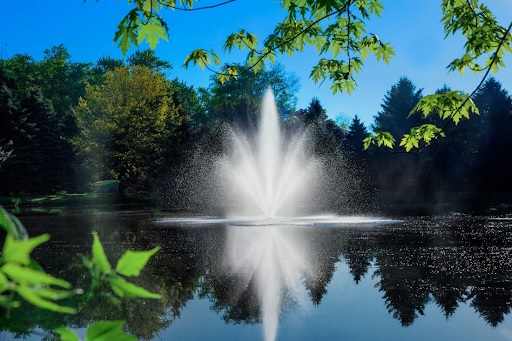Nothing transforms an ordinary waterscape quite like the rhythmic dance of water droplets catching the sunlight. Ask anyone with a pond or small lake – that moment when stagnant water gives way to dynamic movement marks a turning point for both beauty and functionality. Beyond mere decoration, moving water serves as nature’s lifeline, silently working to maintain crucial balances that support everything from microscopic organisms to the prize koi in the pond.
Homeowners who install Scott fountains often report dramatic improvements within weeks of setup. These systems tackle the silent killers of pond health – stratification and oxygen depletion – while simultaneously creating visual focal points that enhance property aesthetics. The actual installation process, however, hides numerous pitfalls that separate long-term success from frustrating failure. Cutting corners during setup virtually guarantees disappointing performance, regardless of equipment quality or initial investment.
Table of Contents
Analyzing Your Specific Water Conditions
No two bodies of water behave identically. Shallow decorative ponds face vastly different challenges than deeper recreational lakes, necessitating customized approaches rather than one-size-fits-all solutions. Water depth measurements should include multiple points throughout the pond, as irregular bottoms create unexpected current patterns that affect circulation effectiveness. Seasonal fluctuations further complicate matters – a fountain perfectly positioned during spring rains might sit awkwardly exposed during late summer droughts.
Surrounding features dramatically influence both practical and aesthetic aspects of fountain performance. Mature trees dropping leaves require strategic placement to minimize intake clogging. Nearby structures create wind tunnels that push spray in unexpected directions. Even soil composition matters – some pond edges gradually release tannins that affect water clarity and equipment performance. Taking time to document these site-specific characteristics prevents costly adjustments later.
Electrical Setup – Where Most Installations Fail
Talk with experienced pond managers and they’ll inevitably mention electrical issues as their most common headache. Underground conduit requirements vary dramatically between locations, with some jurisdictions requiring specific burial depths and inspection protocols. Cutting corners on wiring quality virtually guarantees premature failure – standard residential-grade materials simply cannot withstand constant moisture exposure and temperature fluctuations.
Voltage considerations frequently derail otherwise promising installations. Equipment rated at specific voltages experiences significant performance drops when power fluctuates beyond acceptable ranges. Long cable runs between power sources and water features require careful calculation of voltage drop – a factor many overlooked during planning. Skimping on properly sized wire practically ensures disappointing performance and shortened equipment lifespan, regardless of fountain quality.
Anchoring Methods That Prevent Costly Failures
Nothing undermines the performance of fountains faster than improper anchoring. Fountains that shift position during operation create uneven wear patterns that damage internal components while disrupting intended spray patterns. Different bottom materials demand specialized approaches – sand requires broader weight distribution while clay allows more concentrated anchoring points. Seasonal ice formation further complicates matters, as expanding ice sheets can drag improperly secured units across pond bottoms.
Corrosion represents another silent destroyer of anchoring systems. Standard hardware store chains and cables quickly deteriorate in water, particularly in ponds with chemical treatments or naturally acidic conditions. Marine-grade components cost more initially but prevent middle-of-season failures that ruin planned gatherings and require messy mid-season repairs. Planning for accessible maintenance without complete system removal requires thoughtful design rather than hasty placement.
Weather Considerations That Determine Success or Failure
Regional climate patterns dictate critical installation decisions. Northern locations require specific winterization protocols that prevent catastrophic freeze damage. Equipment installed at improper depths faces ice encasement that cracks housings and damages impeller assemblies. Southern installations battle different enemies – excessive heat and evaporation that concentrate minerals and accelerate algae growth. Adjustable intake depths allow seasonal optimization without complete system redesign.
Wind patterns create headaches that thoughtful placement prevents. Prevailing breezes push spray toward shorelines, potentially creating soggy areas and water loss. Occasional strong gusts affect different spray patterns unequally – some designs maintain aesthetic appeal despite wind while others collapse into messy splashes. Taking time during installation to observe site-specific conditions pays dividends throughout years of operation.
Aesthetic Choices With Practical Implications
Spray pattern selection goes beyond simple preference to impact overall system effectiveness. Vertical patterns maximize oxygen transfer while minimizing water loss. Wide, cascading displays create impressive visual effects but sacrifice functional benefits and increase evaporation rates. The best installations balance these factors rather than focusing exclusively on either appearance or function.
Nighttime lighting transforms evening experiences but demands integrated planning during initial installation. Retrofit lighting rarely achieves the seamless appearance of systems designed with illumination in mind. Cable routing, fixture placement, and control system access require consideration before equipment enters the water. Hasty decisions during installation create maintenance nightmares that frustrate even the most patient pond owners.
Conclusion
Thoughtful installation practices separate disappointing water features from showcase installations that enhance property enjoyment for years. Each decision during the setup process ripples through subsequent seasons, either simplifying maintenance or creating ongoing frustrations. Taking time to understand site-specific factors before equipment selection and placement prevents the disappointment of underperforming systems despite significant financial investment.
The transformative power of moving water extends beyond simple aesthetics to create vibrant ecosystems that support diverse wildlife while enhancing human enjoyment. Proper installation creates the foundation upon which these benefits build, turning ordinary water features into extraordinary focal points that mature gracefully through changing seasons.

